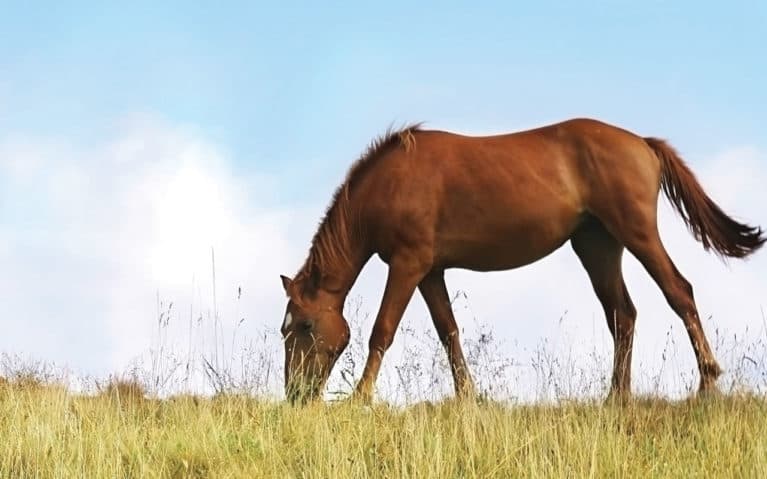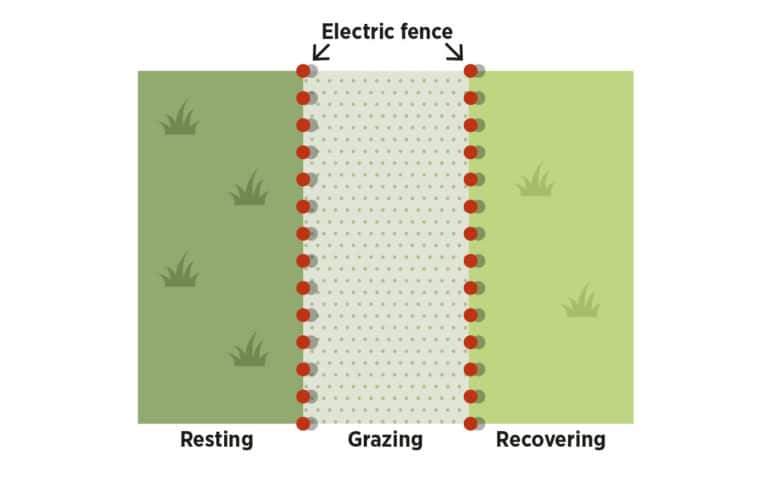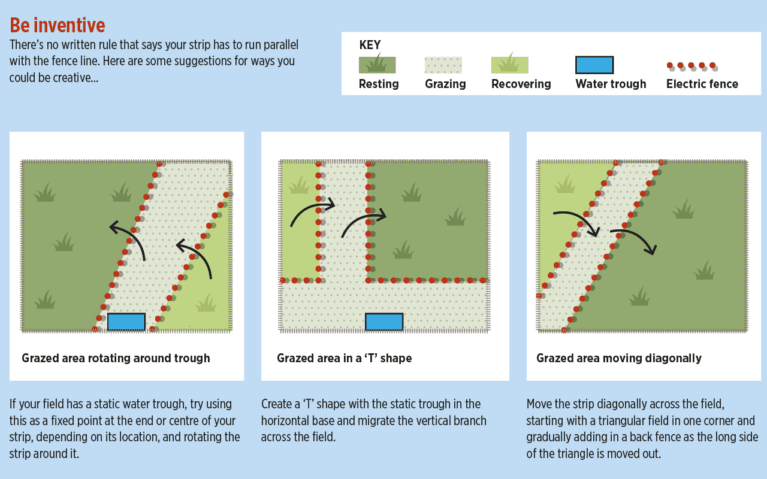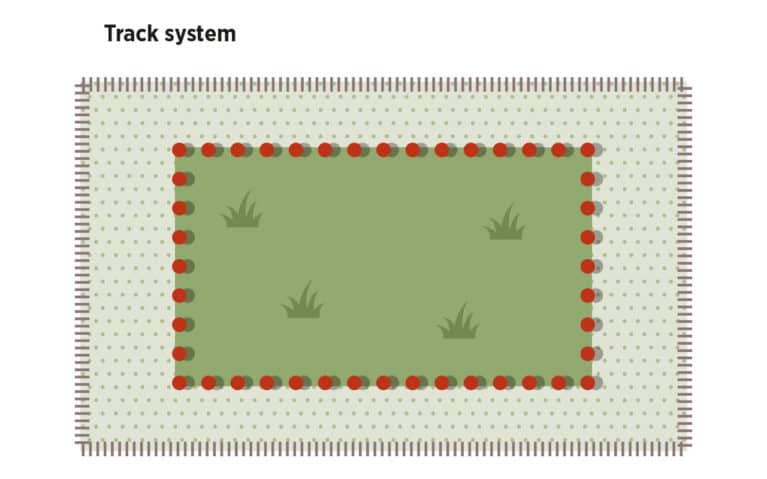Warmer weather means rapid grass growth, so it may be time to rethink how much your horse has access to. Rachel Dyke explains the benefits of strip grazing and how to implement it

While you’re probably familiar with strip grazing as a method of restricting grass for tubby ponies, you may not be aware that it’s benefits are much wider-reaching.
Strip grazing involves fencing off a small strip in your horse’s pasture and moving the fences regularly to allow your horse access to fresh grass. How often you move the fencing is determined by grass growth and your horse’s appetite, and it may vary throughout the year, particularly during spring and summer when the grass is growing up to five times faster than in late autumn.
Both the fences of the grazing area should be moved at the same time, so the strip naturally migrates back and forth across the pasture. This creates three different areas of the field — the recovering, grazing and resting areas (see diagram, right) — although the size of these will fluctuate depending on the location of the strip.
Why strip graze?
There are three main reasons for strip grazing…
To protect your pasture
It helps the grass to grow at a healthy, productive rate because only a small area of the pasture is grazed at a time, while the ungrazed areas are rested and allowed to recover. Overgrazing without resting will result in reduced grass growth and quality, as horses will tend to eat the more palatable species first. When paddocks are overgrazed, bare areas are quickly filled with weeds.
To manage weight
It reduces your horse’s grass intake, which can help to manage his weight. Grass is high in soluble carbohydrates (fructans), which can lead to problems such as obesity and laminitis if ingested in large quantities, particularly in the spring and autumn. However, the amount of grass made available in the strip will dictate how successful it is in controlling his weight. You’ll probably need to use strip grazing alongside other weight management methods, such as time in the stable or fitting a grazing muzzle, at times of rapid grass growth.
To acclimatise to a new field
It can be used when moving your horse to a field with more grass than he’s accustomed to. The strip can gradually be made wider as he adjusts to the extra grass, provided that this doesn’t lead to excessive weight gain.

What do you need?
Because strip grazing involves regularly changing the paddock boundaries, it’s best to use electrical tape and posts to divide the field. These are cost-effective, and can be erected and moved easily. An electric current is recommended to help deter your horse from trying to gain access to the ungrazed grass on the other side of the fence.
When implementing a strip-grazing system, it’s important to make the strip wide enough so your horse can easily turn around and horses can pass each other without getting too close. Aim for at least ten metres.
How to strip graze
- Fence out your strip using electric tape and posts. Make sure the strip is the right size for the horses grazing it, and there is access to adequate shelter and fresh water.
- When the grass has been eaten down, move the electric posts out by approximately one metre, so that a new strip of grass is included in the grazing section and a grazed strip has been left behind in the resting area.
- Continue in this way until you reach the end of the field, then start to work your way back across.
- Meanwhile, the recovering and resting areas of the field can be harrowed, topped or reseeded, as required.
Important things to remember…
- ensure that the strip is an appropriate size — too little space will put pressure on herd dynamics, possibly leading to confrontation and bullying, and too large a space will mean that grass intake is not effectively managed
- remember to regularly move your fencing to avoid overgrazing and, therefore, damaging your pasture
- with your horses confined to a smaller space, this could put more pressure on the ground, particularly when conditions are wet
- always have some spare posts and tape handy in case of breakages
- it may be hard to judge how quickly the grass is growing, particularly if your horse is eating it down as fast as it grows — use the growth of the rested area as a guide to how much your horse is eating on a daily basis
- avoid having too many corners, which will put strain on your electric posts and cause them to bend
- regularly remove droppings, as the reduced space will result in a higher percentage of ungrazed areas if they are left
- UK pasture is typically low in trace minerals such as copper, zinc and selenium, so feed a vitamin and mineral supplement to ensure your horse has a balanced diet

Staying on track
Track systems are an alternative to strip grazing. Rather than a strip, the paddock is divided up into a loop shape, often following the fence line, with an ungrazed area in the middle — think of a race track. Systems like this are considered by some to be more natural for the horse than a strip or regular paddock, as it encourages more movement while grazing. This mimics the greater distances that a horse might cover while foraging in the wild. The extra movement can also help to burn calories — every little helps for those watching their weight.
A track system offers less in the way of grazing rotation, as the track doesn’t move across the field like a strip does, which can result in bare patches or weeds in the field. These areas may need reseeding after the horses have moved on. You may also need to provide supplementary forage, such as hay, haylage or a chopped fibre to top up the overgrazed grass.
Some people add different surfaces to their tracks, such as rocks or sand, to mirror the environment a horse might experience in the wild.

Making hay when the sun shines
Another reason for implementing strip grazing could be to set aside some of your pasture for hay-making. This means that you can be confident of the quality and source of your hay, and you’ll have a better idea of its nutritional value. However, there are some important things to consider…
animals will need to be kept off the grass for at least four months during the growing season
hay needs to be dried on the field for around five days after cutting, so aim to do this in a long spell of dry, sunny weather so that the crop doesn’t spoil
making your own hay may seem like a cheaper option, but it requires specialist equipment, so you may need to factor in the cost of hiring a contractor or local farmer to cut and bale your hay
consider whether you have the available storage space for your harvest — you can expect 50-100 small bales from one acre of land, depending on the grass type, quantity and quality
Before you set about making your own hay, always seek advice from a specialist contractor so that you can get the best harvest possible.
Your Comments
One thought on “Strip grazing explained”
Leave a Reply
You must be logged in to post a comment.
















Hi, I have an acre field for 2 horses. The field hasn’t been used since it was cut for hay last August so the grass is very long with lots of plantain. I have heard the racetrack strip grazing method might be best. How wide should the strip be? I’m a novice so any advice appreciated!